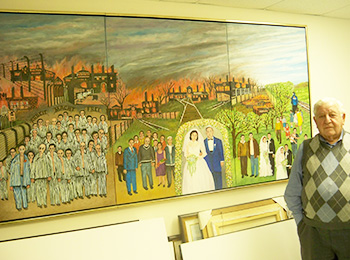MONTREAL — Abe Pinchuk swam almost every day in his condo pool with another resident, also a retired businessman of about his age. They became friendly, but it was a few years before Pinchuk learned that his companion was a Holocaust survivor.
Little by little, Pinchuk found out that this Hungarian native had, from the age of 15 in 1944, survived five concentration camps including Auschwitz, and the death marches.
He lost his mother and several siblings. He himself barely lived, and was almost left for dead by the liberating U.S. Army. He came to Montreal as a war orphan.
Yet, the man seemed quite content, had enjoyed a degree of prosperity and he and his wife, whom he married here, had two sons and a growing number of grandchildren.
Although Pinchuk had made most of his living in the textile trade, he was always an artist, and an accomplished one at that, best known for his landscapes.
“There was something about his story, which I gathered piecemeal, that moved me, that convinced me I had to create something that would tell the story of how he – and many other survivors – despite what they went through, not only survived but rebuilt their lives, were fruitful as the Bible says, and that their children and grandchildren are carrying that on.
“And these survivors did so with courage, dignity and determination.”
But there was one obstacle for Pinchuk, now 85. “I would never have touched the Holocaust with a 10-foot pole. I felt I did not have the right to. I’m not a survivor. I was born in Montreal. My parents came here in 1905 fleeing the pogroms after the Russian Revolution,” said Pinchuk, who grew up on Craig Street, the son of a poor shoemaker. He was able to study for three years at the Montreal Museum of Fine Arts thanks to a scholarship recognizing his precocious talent.
Pinchuk’s hesitation proved to be unwarranted. His pool pal liked the idea and so began Pinchuk’s months-long work on a painting entitled How 77835 Defied the Nazi Final Solution that included reading up on the history of the Holocaust, as well as many hours at the easel.
His subject had one caveat: that the identity of 77835 – the number the Nazis assigned to him, which he wore on an ankle shackle – not be revealed.
The painting, an 8-foot by 4-foot triptych in oil, is having its first public exhibition in the Federation CJA Cummings House lobby until April 28, sponsored by the Jewish Public Library and Montreal Holocaust Memorial Centre. The exhibition is part of the annual Yom Hashoah commemoration.
The three panels follow the journey of 77835. The first depicts a group of bewildered inmates in striped uniforms as they emerge from the camp after liberation. In the front row on the left is 77835. He is the only one whose stripes are blue instead of black.
In the second scene is a happy young couple under the chupah – 77835 and his bride, painted from their actual wedding photo. He is in a blue suit. Behind them are many of the former inmates, looking healthier and well dressed.
In the final panel, two other young couples marry – his sons and daughters-in-law (also accurate portraits) – and children frolic. 77835 can be seen walking off in the distance with his grandchildren (he now has five and two great-grandchildren). He’s wearing a blue windbreaker with a Star of David on the back. It echoes the symbol he was forced to wear in the first scene; this time he wears it with pride, Pinchuk explained.
Blue, of course, is the colour associated with the State of Israel.
The work is also divided into three horizontally. The lowest stratum is the life story. Above that are disturbing scenes of the death camps, their oven doors open, the train tracks and barbed wire.
The camp buildings are all ablaze. “Let them burn in hell forever,” Pinchuk said.
By the third panel the smoke has cleared, and the tracks no longer seem menacing.
The uppermost layer of sky repeats this progression from darkness to light, as the storm clouds give way to sunshine.
“The first time he and his wife [who is European-born but not a survivor] saw the painting, they both cried,” said Pinchuk. “It’s a legacy for them and their family.”
77835 told The CJN matter-of-factly, “That’s the story of my life after the war. I had some success and a nice family.”
As someone who has spoken to students about the Holocaust, he recognizes the painting’s educational value. “Everybody has to know these things,” he said. “We have to talk about it.”
His wife, who was born in Switzerland during the war, added that it is true her husband “has done well after so much loss, prospered to a degree and multiplied. It’s a small miracle.”
“At 85, I’m very lucky I can still do this, and work very fast,” said Pinchuk. “I completed the triptych in three months, but that was working day and night practically.”
Pinchuk is now looking for a permanent home for the painting, somewhere, preferably on this continent, where the story can continue.
